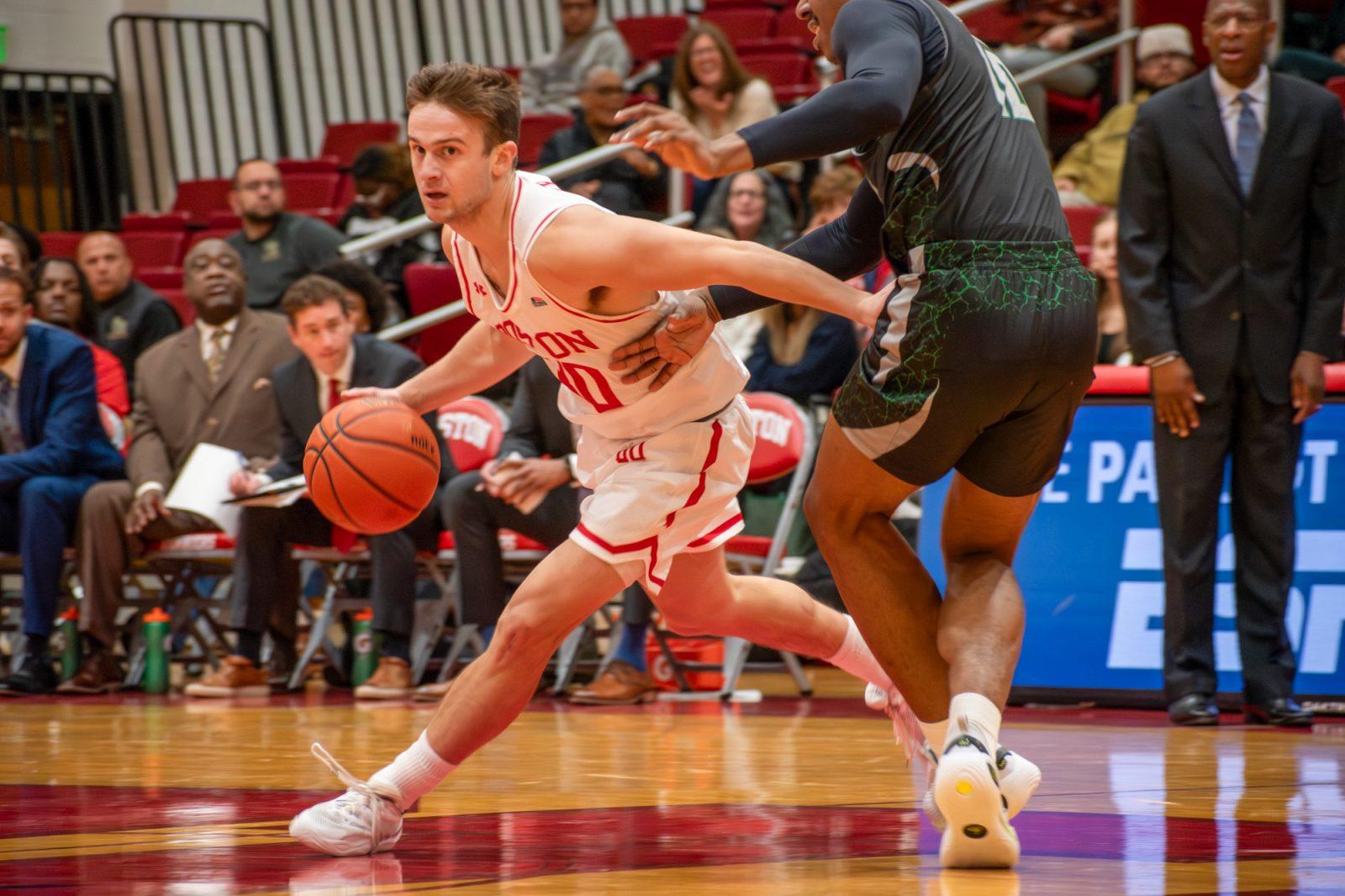Agganis Arena is a collegiate athletics palace. Not only has it hosted every men’s hockey game since it opened in 2004, but it has played home to 13 Boston University men’s basketball games, the America East Tournament, multiple concerts and a handful of women’s athletic events. ‘The Greek’ is a crucial tool for publicizing BU’s prominent programs, as well as its main bargaining chip when trying to attract fans at a university where the student population is largely apathetic toward athletics.
Eventually, the athletics department wants to hold every basketball game at Agganis, but when and if that will ever happen is yet to be determined.
‘This building was built with the idea that in some point in time, all of our basketball and all of our hockey games will be played here,’ Director of Athletics Mike Lynch said last month. ‘Certainly having six [basketball] games here is a huge step in the right direction in terms of building our program.’
Whether BU should be playing basketball at Agganis at all has been a hotly contested issue, as – despite the atmosphere and immaculate amenities it provides – the team has never performed well within its walls.
There are many avenues to traverse when attempting to explain the Terriers’ lackluster performances at Agganis, but before any are discussed, it’s important to digest the statistics.
In 13 games over four-plus seasons at Agganis (including the Terriers’ 63-58 overtime loss to George Washington University to start this season), BU has shot 34.6 percent from the field, 24.3 percent from 3-point range and converted free throws at a 57.5-percent clip. Overall, during the same period of time, the Terriers have shot 41.6 percent from the field, 33.5 percent from beyond the arc and 67.3 percent from the charity stripe. Very few college basketball teams have a worse free throw percentage in their home splits compared to the season as a whole.
Within the four-year period, BU has never converted more than 22 field goals in a game and never scored more than 62 points at The Greek. Opponents haven’t fared well, either, as the highest-ever point total (70) was tallied by GW on the heels of a nationally ranked campaign and Vermont last year. Overall, visitors are averaging 57.2 points per game at Agganis, while BU is averaging 51.7.
Why has BU played so much better at Case Gymnasium (and even in the majority of its road games) than at its state-of-the-art arena across the street from The Roof?
One reason could be the Terriers’ strength of schedule at Agganis. Because of BU’s desire to draw enough fans to fill the facility when the Terriers play there, opponents who visit are usually of a higher caliber, whether hailing from outside or within the conference. The University of Michigan, the University of Rhode Island, George Washington (twice), the University of Massachusetts-Amherst, St. Joseph’s University and conference rival the University of Vermont have all scored victories on the Agganis hardwood.
It’s not as though there haven’t been close games at Agganis. BU lost by two against UMass two years ago, beat UVM by two the season prior and lost to the University of Maine by two that same season. But one wonders if those outcomes would have been different if BU didn’t shoot below 40 percent in each one.
‘I have never played a good game in there,’ junior co-captain Tyler Morris said prior to the start of the season. ‘If you go back, I think I scored in double figures one time. That’s all irrelevant, because now we’re talking about superstition and ‘The Curse of Agganis.’
‘But you practice all the time in Case and you get used to the surroundings – how high the ceiling is, peripheral vision, you know where the baselines are – so when you go in Agganis, it takes a little bit away because when you’re playing, you’re kind of taking in the surroundings as well.’
Practice time is another key factor in trying to explain the Agganis hex. In the past, the Terriers have never had more than one day of practice at Agganis due to the men’s hockey team’s practice schedule ‘-‘- all other basketball practices are held at Case. That’s why there are some questions as to whether eventually transferring every game to Agganis is such a good idea. Is the practice-to-game crossover between venues too much of an obstacle to overcome? And if so, would the Terriers ever be able to get enough practice time at Agganis to have it feel like a true home game?
‘It’s like a road game with home fans,’ junior co-captain Corey Lowe said before the season. Lowe’s first game of the season at Agganis was one of the worst of his career, as he shot 2-of-15 and 1-of-11 from 3-point range.
Despite the players’ reservations regarding their past performances at Agganis, associate head coach Orlando Vandross sees it differently.
‘The shooters make the adjustment and that’s the bottom line. You can’t tell an NBA player who’s making $5 [million] to $10 million that you look great in practice, but when the lights are on that’s a different story,’ he said before the season.
‘It’s our home court. We’re always excited to get in that building and try to play. It’s our program and it’s the feel of the program that makes it a great place to watch a game,’ he added. ‘I give BU and the administration a lot of credit for looking down the road to try and pull off a situation where we’re there on a full-time basis.’
Still, it appears shooters have not yet been able to make the adjustment.
‘I can only remember one person having a good shooting game in there and that was [Carlos Strong],’ Morris said.
Strong’s 19-point performance in his first-ever game at BU is fourth-best all-time by a Terrier at Agganis. Rashad Bell scored 29 in the inaugural game at Agganis on Feb. 12, 2005. Chaz Carr scored 24 points in the same game and John Holland’s 22-point outburst to open the 2008-09 season was just the third 20-plus point performance by a BU player at The Greek.
Even opponents have a difficult time at the arena, as only five players have ever netted more than 20 points at Agganis, with the record holder being UVM’s Taylor Coppenrath, who netted 37 in that inaugural contest in front of 5,738 fans.
It’s not as though other schools don’t adapt to similar situations. Larger programs play games at a home gym and host marquee or television matchups at the local professional arena, while schools as close as Northeastern University split time between two arenas.
Still, no matter the reason ‘-‘- whether it be the quality of opponent, BU’s inability to log substantial practice time at Agganis or the big-game atmosphere ‘-‘- the Terriers have never performed well there. What remains to be seen is if BU’s five (possibly six, pending the Terriers’ placement in the BracketBusters tournament) remaining games at Agganis will do anything to change that.






















































































































Vince • Aug 3, 2010 at 2:20 pm
They’ll learn to play there. Eventually they will have to because there really is NO debate. Agganis is so central to the future of the program. If the team continues to play at Case, URI, UMASS GW and the like won’t even agree to home and home series with BU. You’re not giving enough credit to the quality of opponents there either…it’s much harder to beat those teams. <p/>Frankly, losing in overtime to GW in front of 4700 fans is arguably better for the BU ‘program’ than beating some inferior team like in front of 600 at Case. If this group doesn’t perform at Agganis, then the next one will.
Tall Man • Aug 3, 2010 at 2:20 pm
The cold spell will end. Keep recruiting ahead of the league. Schedule good competition for Agannis. Let’s keep putting people in there like we did against GW this year (great atmosphere, great defending, poor shooting, as the article makes clear), and the program will grow.